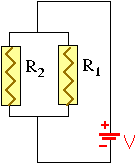 It
probably won't surprise you that we now want to calculate the
equivalent resistance of two resistors in parallel. From a comparison
with the results for capacitance
circuits you can probably also guess what the result will be.
It
probably won't surprise you that we now want to calculate the
equivalent resistance of two resistors in parallel. From a comparison
with the results for capacitance
circuits you can probably also guess what the result will be. It
probably won't surprise you that we now want to calculate the
equivalent resistance of two resistors in parallel. From a comparison
with the results for capacitance
circuits you can probably also guess what the result will be.
It
probably won't surprise you that we now want to calculate the
equivalent resistance of two resistors in parallel. From a comparison
with the results for capacitance
circuits you can probably also guess what the result will be.
Two resistors are in parallel, if they are connected across the same potential drop. This means that, generally, different currents will flow through them. One example would be two lamps or two electrical appliances on the same household circuit.
canceling out the factor V:
|
|
|
|
|
|
|
|
|
|
||
|
|
|
|
Another way to write this is,
|
|
|
|
|
|
|
|
For n resistors this generalizes to:
|
|
|
|
|
|
|
|
|
|
|
|
|
|||
|
|
|
|
|
Adding another resistor in parallel always reduces the total resistance.
© MultiMedia Physics 2000